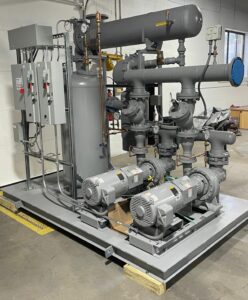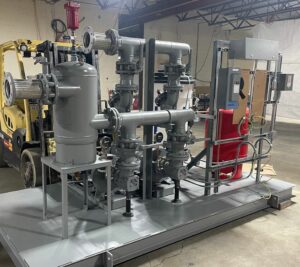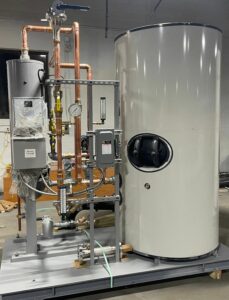What is a Mechanical Room Package?
A packaged piece of equipment is simply a number of components, pre-piped, wired, and with controls. The components are selected so they interact with each other harmoniously to provide the engineer’s desired output into the system.
A traditional example packaged system is the hydronic heat transfer package. The package would include water-to-water or steam-to-water heat exchanger(s), air and dirt control devices, expansion tank and trim, and heating pumps with valves and trim. All of this is mounted on a frame with the electrical controls and drives. The result is a small mechanical room on a skid. The engineer requests the required flow rate, pump head external to the package, and hydronic temperatures in and out. A simple solution with unit responsibility.
Why Engineers May Use a Packaged Solution
There are four reasons an engineer would specify a packaged product for the mechanical room.
1. Knowledge Gaps
The first is solving gaps in knowledge by the engineering staff. Today we are all faced with the challenge of finding qualified employees. It is not unusual for an engineer to ask if we know of any “good” engineers looking for a position.
Once you hire, you must determine what the new employee knows and what they need to learn. Choosing a packaged solution allows the engineer principal to have the new employee work on the capacities required without sweating the risk in selection, interaction, and detailing of the components.
You may have great air side engineers but a weakness in the hydronic end. There may be hydronic experts, but the steam knowledge retired three years ago. Maybe there is a gap in plumbing system interaction. The packages transfer the knowledge of selection and interaction to the package manufacturer. Packages go a long way to help with knowledge gaps.
2. Risk
The second reason to use a packaged solution is reduced risk. Risk may come from incomplete or incorrect details. Risk may come from operational issues outside of a product’s published IOM. Risk may come from the inexperience of an installing contractor. They are also looking for people these days.
If there is an issue on the job, a single call to the single party responsible will reduce meeting time and finger-pointing. The package’s output remains the responsibility of the engineer. The risk of how the pieces and parts go together can be significantly reduced with a package.
3. Time
The third reason is simply lack of time. The industry is very busy right now. Often, we are working on multiple projects concurrently with tighter and tighter deadlines. Off-loading the mechanical room design to a packaged supplier will allow more time to work on the design. Provide the output required from the packaged equipment and upload the Revit file solution.
4. Space
This may seem odd (just kidding of course) but unusually tight space is a common complaint of HVAC and plumbing engineers. We have met many challenges of fitting equipment into narrow or tight spaces while still getting the proper clearances and services area. Fitting the proverbial 10 pounds in a five-pound bucket is not unusual for quality package suppliers to overcome.
What Type of Packages Should the Engineer Consider?
There is no limit to the type of packages available. Here are some ideas:
- Steam pressure-reducing stations
- Heat transfer packages
- Cooling tower pumping packages
- Boiler and pump packages
- Water heater systems
- Radiant system packages
- Snow melting packages
- Steam deaerator & accumulator packages
Challenge your R. L. Deppmann sales engineer to offer a couple of solutions during your next project D-D (design development) phase. You may be able to fill knowledge gaps, reduce risk, save time and money, and meet the space limitations from the architect.




